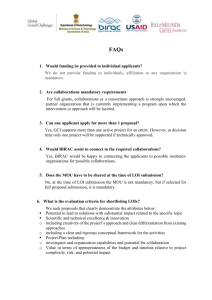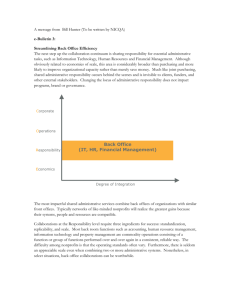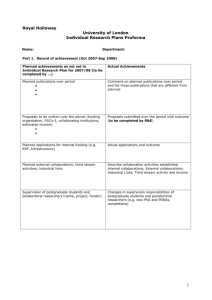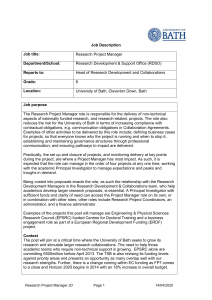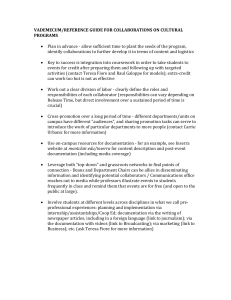Seven Keys to Successful Collaborations
advertisement
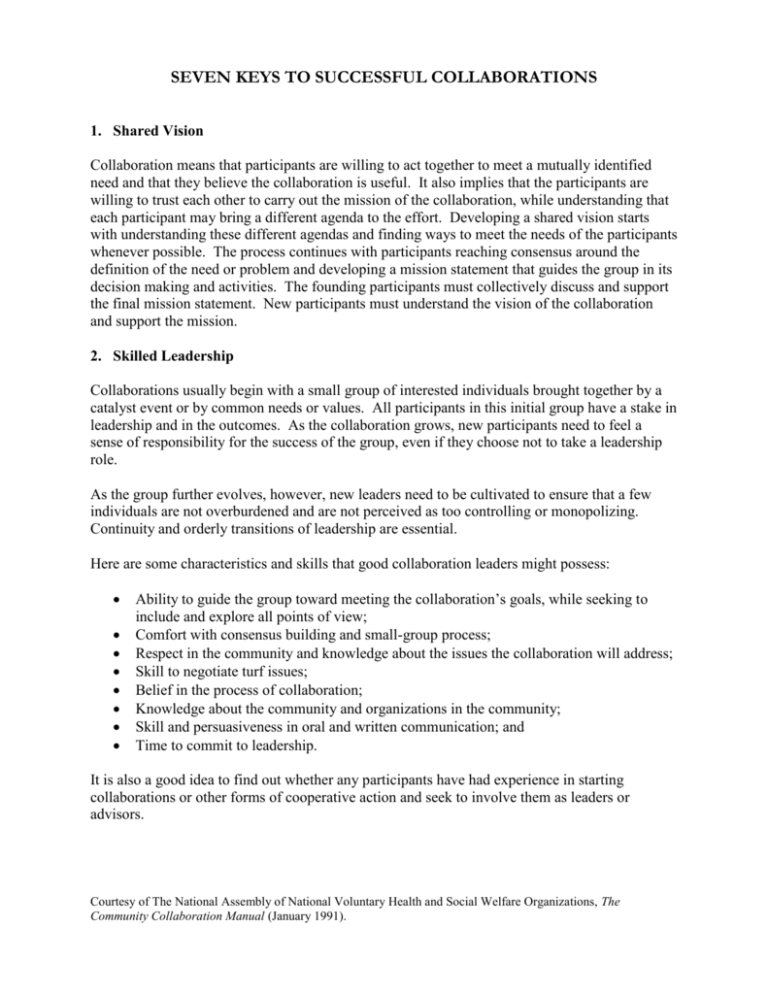
SEVEN KEYS TO SUCCESSFUL COLLABORATIONS 1. Shared Vision Collaboration means that participants are willing to act together to meet a mutually identified need and that they believe the collaboration is useful. It also implies that the participants are willing to trust each other to carry out the mission of the collaboration, while understanding that each participant may bring a different agenda to the effort. Developing a shared vision starts with understanding these different agendas and finding ways to meet the needs of the participants whenever possible. The process continues with participants reaching consensus around the definition of the need or problem and developing a mission statement that guides the group in its decision making and activities. The founding participants must collectively discuss and support the final mission statement. New participants must understand the vision of the collaboration and support the mission. 2. Skilled Leadership Collaborations usually begin with a small group of interested individuals brought together by a catalyst event or by common needs or values. All participants in this initial group have a stake in leadership and in the outcomes. As the collaboration grows, new participants need to feel a sense of responsibility for the success of the group, even if they choose not to take a leadership role. As the group further evolves, however, new leaders need to be cultivated to ensure that a few individuals are not overburdened and are not perceived as too controlling or monopolizing. Continuity and orderly transitions of leadership are essential. Here are some characteristics and skills that good collaboration leaders might possess: Ability to guide the group toward meeting the collaboration’s goals, while seeking to include and explore all points of view; Comfort with consensus building and small-group process; Respect in the community and knowledge about the issues the collaboration will address; Skill to negotiate turf issues; Belief in the process of collaboration; Knowledge about the community and organizations in the community; Skill and persuasiveness in oral and written communication; and Time to commit to leadership. It is also a good idea to find out whether any participants have had experience in starting collaborations or other forms of cooperative action and seek to involve them as leaders or advisors. Courtesy of The National Assembly of National Voluntary Health and Social Welfare Organizations, The Community Collaboration Manual (January 1991). 3. Process Orientation While collaborations live by their results, the process of collaborating is itself an end worth pursuing. Attention always needs to be focused on the process of including people in the shared decision making of the collaboration. Many groups strive for consensus. This ensures the opportunity for all participants to have input and gives minority opinions a full hearing. Because participants always “come to the table” with their own agendas, it is important to maintain the focus on the agreed-on mission, while simultaneously striving to meet participants’ needs. Some form of conflict is natural as various parties engage in collaborative efforts. Change brings about a certain degree of discomfort and disagreements over turf. The key is to manage the conflict and channel it into useful solutions. When conflict occurs, it must be addressed sensitively, using effective communication skills. 4. Cultural Diversity The collaboration must be open to the richness that comes from including members of different cultural, racial, ethnic and income groups. It must recognize the commonality of all human beings, while treasuring the unique aspects that various cultures bring. Understanding differences in language, customs and values is vital. If there were no differences among groups, life would be less exciting––and there would be little need for collaborations. Members of each culture need to examine their own assumptions about other cultures and act to correct misunderstandings. Collaborations provide the “common ground” for this to occur. Participants need to devote the necessary time and energy to ensuring that they communicate clearly with members of other cultural groups. Often the effort needed to communicate successfully with someone from another culture results in a new perspective on the topic and creative solutions to problems. 5. Membership-Driven Agenda Groups join collaborations to meet organizational needs. Participants must acknowledge and clarify their needs to allow as many individual needs to be met as possible. People need to feel important and included. Ongoing assessment on how well the collaboration is meeting the needs of its members enhances the viability of the group. All participants should contribute resources to the collaboration. Many successful collaborations, especially at first, receive most of their resources from their members. These resources may include time, space, contacts, in-kind resources or financial resources. When members contribute resources, their sense of ownership in the collaboration is increased. But there should be a balance in the relative level of contributions from various participants. Sometimes, organizations that contribute large amounts of resources accrue a disproportionate amount of power. While this is sometimes unavoidable, it can prevent other members from feeling included. Courtesy of The National Assembly of National Voluntary Health and Social Welfare Organizations, The Community Collaboration Manual (January 1991). 6. Multiple Sectors Successful collaborations seek to include as many segments of the community as are compatible with the mission of the collaboration. Collaborations exist to represent certain viewpoints or stands on issues or they seek to bring together organizations in a particular endeavor. They establish the criteria for participation to guide them in making appropriate matches between new members and the mission of the group. Some collaborations purposely limit participation to ensure that members’ goals are consistent with the group’s mission. Advocacy groups generally include only those organizations that share consistent values or positions on the group’s issue(s). Others limit participation because they focus on a particular problem area, such as increasing communication between schools and government organizations that investigate and prosecute child abuse cases. Some collaborations involve only two or three organizations and are kept small intentionally. These are more properly called “partnerships” and are a viable means of encouraging collaborative efforts. Other collaborations attempt to mobilize an entire community around an issue or set of issues. For these groups, it is important to be as inclusive as possible. Organizations not likely to be represented need to be brought into the process. Depending on the traditions of the particular community, these often-forgotten groups may include businesses, grassroots groups, minority and ethnic groups, government, youth and service clubs. One of the strengths of collaborations is that they bring together different segments of the community around a particular need or concern and attempt to forge a new style of working together. Strength comes from the diversity of the collaboration. Encouraging as much diversity as appropriate for the collaboration is important. Diversity can result in creativity, increased understanding and enhanced political clout. However, tokenism should be avoided! The group must be open to authentically involving all members in the process. 7. Accountability Collaborations exist to achieve certain specified results and outcomes. The process of developing a shared vision with appropriate goals and objectives should aim toward these clearly stated results. Accountability means specifying results anticipated at the outset, and then continuously monitoring progress so mid-course corrections can be made. An evaluation of collaboration efforts and results should be planned from the outset to help collaborators decide how various efforts should be modified, expanded or dropped. Attention to accountability in the early stages of building the collaboration helps avoid the temptation to over-promise and helps to set realistic expectations for the collaborators and those the collaboration seeks to serve. Courtesy of The National Assembly of National Voluntary Health and Social Welfare Organizations, The Community Collaboration Manual (January 1991).


